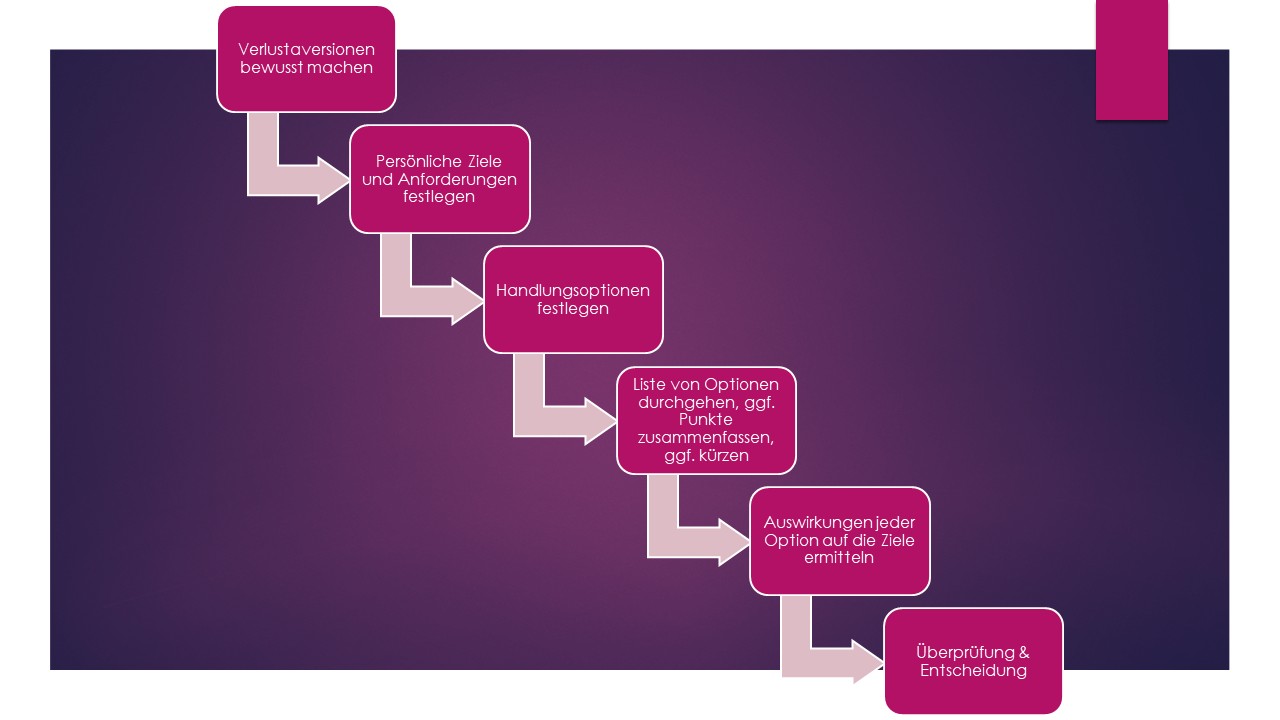6 Steps To The Decision
A guide to making sensible decisions

We make thousands of decisions every day. We encounter most of them unconsciously. These are mostly (everyday) decisions:
- Coffee or tea?
- The black or the brown shoes?
- Am I going left or right?
- ...
However, we make the big decisions consciously. These require time and effort as they have a significant impact on our lives. They should not only be hit “from the gut” nor only rationally (with the head).
- Career choice
- Partner choice
- Desire to have children
- ...
Evaluate Decisions
The result is not decisive for the evaluation of a decision.
Good Decisions Can Have Bad Consequences.
Suppose I forgot an important appointment. If I take the next train, I arrive stressed out 5 minutes before the start (if the train is on time). According to Google Maps, I can reach my destination 30 minutes earlier if I drive to the appointment. So I decide to take the car. Unfortunately, a rear-end collision occurs on the way because another driver overlooks my brake lights. Of course I miss the appointment. Nevertheless, it was the right decision to take the car instead of the train.
Here you can clearly see that bad luck influences the outcome of my decision. However, the quality of my decision remains the same.
Bad Decisions Can Have Good Consequences.
Let's assume the other way round, I still decide to take the train. She's late and I'll miss my appointment. However, I find a 100 euro note under my seat. Was it a good decision to take the train? It remains that it was not a good decision.
It is therefore important not to evaluate a decision based on the result, but based on the quality and whether the decision was made in a considered manner.
Combination Of Head And Belly
Important decisions require both the inclusion of one's own experience and intuition as well as rational consideration. If both factors are included in the decision-making process, these are so-called reflected decisions.
Head decisions are expensive for our brain. Our gut feeling allows us to make quick decisions. Our experiences and our personal well-being are included in the decision. However, we cannot just rely on our gut feeling.
Cognitive Distortions
The problem with gut decisions is that they are prone to error. We regularly fall victim to several so-called cognitive distortions.
Availability Heuristic
This cognitive bias overvalues our experiences or current events because they are readily available.
Example: The last three times I took the bus, it was late. That's why I drive the car. We use the bus = late shortcut, which is readily available based on our experience, without considering the many buses that are on time every day.
Another example: In the last few days, reports have often come out that a train accident has occurred. So I refuse to take the train. Based on current events, we associate the train with an accident, ignoring the many trains that didn't crash.
Loss Aversion
Loss aversion is the reason why we often remain in the status quo, even though we are dissatisfied with our situation. Losses are weighted more heavily than wins; we prefer to maintain a situation that makes us unhappy than to give up the loss of the current situation for possible gain (well-being).
The Way To A Reflected Decision

1. Become Aware Of Loss Aversions
The first step is to become aware of your loss aversion. You should also be aware that change processes very often initially cause discomfort. However, by making reflective decisions, one does a lot to ensure that the desired goals and requirements are met.
Tina is a project manager in a large energy company. For almost a year now, she has seen her professional situation as somewhat muddled. So far, however, she has not been able to bring herself to change her current professional situation. The reason for this – as with many people in the same situation – is loss aversion.
Tina must become aware of her loss aversion in order to take action.
2. Set Personal Goals And Requirements
This step is about becoming aware of the goals you want to achieve with the change. Tina asks herself the question "What is really important to me?".
Tina has the feeling that she is not getting anywhere in her current job. She would like to earn more money so that she can pursue her expensive hobby – skydiving – more often. She would also like to be more active in the field of climate protection. However, flexible time management and home office are also important to Tina so that she can be there for her children after school. Tina prioritizes her goals and requirements:
- Flexibility
- Working with a focus on climate protection
- Higher income
3. Determine Options For Action
This step is about identifying what options Tina has to achieve her set goals. The bird's-eye view often helps to determine possibilities that are not so obvious.
For example, Tina could apply to a competing energy service provider that currently has a vacancy for “Head of Renewable Energies”.
She could also discuss with her manager that she would like to lead the "Wind Turbine in the North Sea" project.
Tina could also become self-employed and offer consulting and project management services on the topic of climate protection.
4. Go Through The List Of Options, Summarize Points If Necessary, Shorten If Necessary
In the next step, you should ask yourself whether options can be combined or shortened if there are more than a handful.
5. Determine The Impact Of Each Option On The Objectives
Self-employment would initially have the advantage of free time management. However, it would often be the case that Tina would have to drive to appointments with her customers, so that she could not spend time with her children after school. Therefore this option is ruled out.
Applying for the position of “Head of Renewable Energies” would generate more money and make more sense. She would also be in the home office four days a week. However, there is a core working time until 5 p.m., so that Tina could only spend time with her children from 5 p.m. Due to the high level of responsibility, Tina will work a lot more than before.
Taking over the management of the "Wind Turbine in the North Sea" project would have the advantage that she would work in the field of climate protection. However, she would then only be able to work from home two days a week after her induction. A salary increase is not expected at the current time.
6. Review & Decision
This is where the stomach comes into play again. The working atmosphere is very important to Tina. She is very satisfied with this in her current company. She has a bad feeling about not seeing her colleagues anymore. Therefore, she decides to take on the wind turbine project at her current company, although on purely rational grounds the best decision would be to accept the position of division manager.
It is important at this point: The more the head was used in the previous steps, the sooner it is time to also ask the gut. A decision can only be made if the head and gut have been involved in the decision-making process.
Summary & Conclusion
For the "big" decisions in life you should ask both your head and your gut. In the decision-making process, one should become aware of one's loss aversion, define personal goals, requirements and values, determine one's options from a bird's eye view and carry out a check against the defined goals and values. Finally, it is important that there is a harmony between the head and the gut feeling.